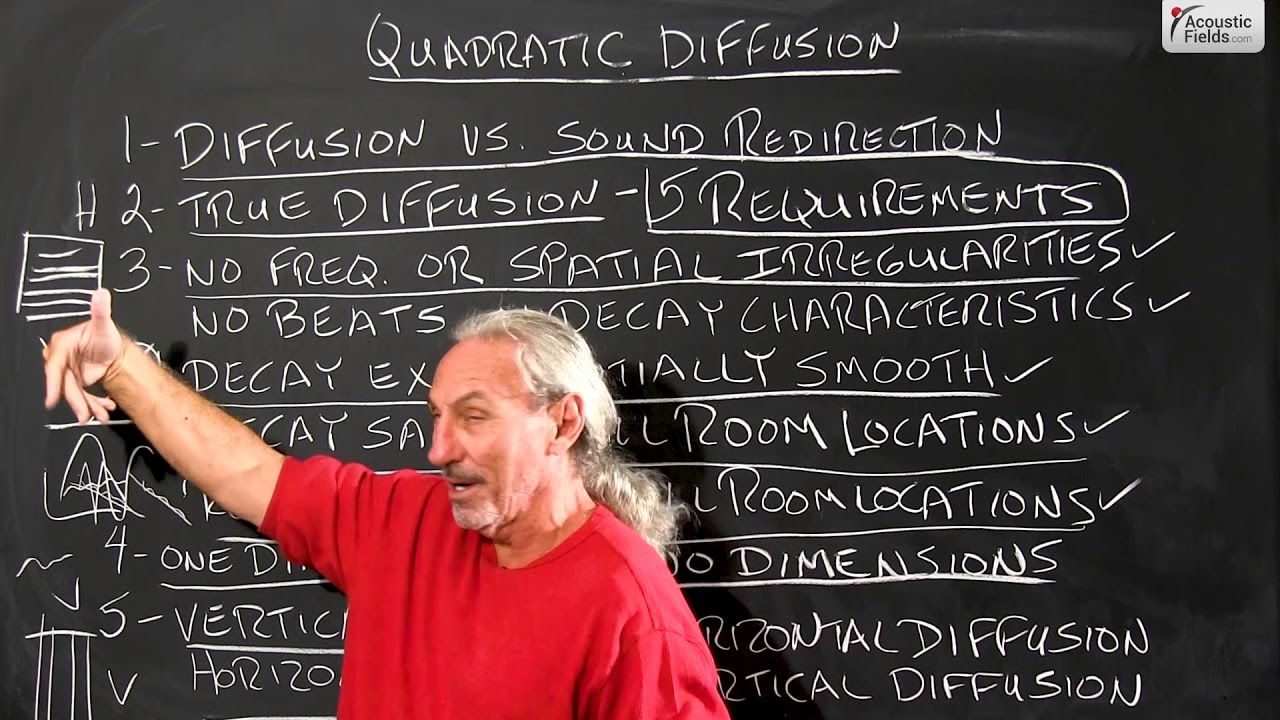Let’s talk about quadratic diffusion. Diffusion in general causes a lot of difficulty for people and I get that because there’s a lot of terms and explanations in the literature that really just aren’t valid at all.
And the first thing we can do to help us with understanding is define the difference between diffusion and sound redirection. Sound redirection if we have a surface and we strike the surface with sound and it reflects back, angle of incidence equals angle of refraction. Remember that from your physics one-in-one course? I’m all stoned.
But anyway, the bottom line here is we have to differentiate between diffusion and just redirecting sound energy. My favorite is the foam diffuser. That’s a great one, how can a sound absorbing device act as a diffuser? And when you see the characteristics and the requirements of a really diffuse sound field in a room you’re going to laugh with me on that one, too.
So that’s a situation where companies take the word diffusion and they apply it to a product that really isn’t a diffuser and if you don’t do your homework and you’re ignorant about the processes of diffusion, you’ll buy it and not be happy. You’ll really just have a piece of foam that may or may not absorb at the rate and level you need. So be really careful out there.
True diffusion, let’s use some real scientific stuff here, has 5 requirements. So if we’re going to have a truly sound diffused field within our room, and there’s 3: vertical, this one, this one and this one, the angled one. So if we’re going to do truly diffused sound field in our room, we have some criteria that we have to meet.
First, no frequency or spatial irregularities in our response curve. So we want nice, smooth response. We don’t want this. We want this, okay? No frequency or spatial irregularities, no beats in the decay characteristics. So none of these. We don’t want this, this, this, this. We want nice, smooth returns. That all can be measured. Okay?
So we want no beats in the decay characteristics and we want the decay to be exponentially smooth, meaning if we have a little bit of rise here and a fall here, then our decay over time has to be smooth. Okay? And here’s a very critical one. And this is why I always harp on where to put treatment. The decay must be the same in all room positions. So we can’t have one part of the room with a decay rate and level X and another part X2. So we have to have it the same in all places.
Here’s another thing people overlook. Reverb. Must be the same in all locations. So we have these 5 criteria that must be met for diffusion to occur. If you don’t have these 5 you don’t have true, diffuse sound field in your room. So the only diffusion type that will give you and meet these 5 criteria is quadratic. It’s just the way it is. That’s all we have right now.
So quadratic is the form that we use and quadratic comes in two types. One dimension and two dimensions. Now, if we look at how they operate I think we can help with these terms. So we’ve all seen vertical diffusers. We sell them ourselves. Their position like that, that’s vertically, okay? And then we see a horizontal diffuser is positioned like this. So this is horizontal. This is vertical.
So the diffused part of the sound field in a vertical rate is this way, in the horizontal domain and in a vertical or horizontally positioned diffuser, it’s this way, in the vertical domain. So it’s contraindicated based on position and you can use both in a room depending on your usage. So there’s where the horizontal and the vertical come in and that’s where we can get two dimensions of diffusion on the same surface. Depends on usage, what you’re trying to do depends on distance from the listener, depends on distance from the source, depends on size and volume of the room. Depends on pressure level, depends, depends, depends, depends. Many variables, okay?
I’ve been doing this for 30 years with quadratic. I’ve strictly focused on quadratic and you can see the results of that on our website in my designs. So if you have any questions about quadratic, it’s not easy to grasp, definitely not something that you can do on your own without a little guidance. You can build the units on your own and we offer you plans to do that. But you’ve got to have a technology that meets those 5 criteria, all right? I hope this helps. Quadratic diffusion, great technology.
—
This is an unedited transcript from our video series from Acoustic Fields. There will be some errors in grammar and sentence structure that occur during this translation process.
For complete understanding and comprehension, please view the video which is included in this text. For any additional information regarding this topic or others relating to room acoustics, please contact us directly at:
P: 520 – 392 – 9486







